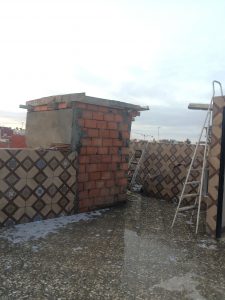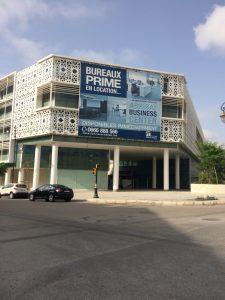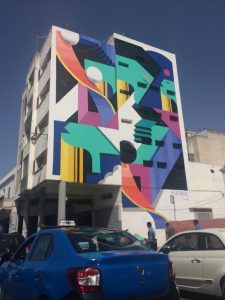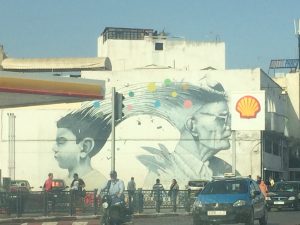One of the early things I saw as we drove into Rabat was a large black opera house surrounded by several bright yellow cranes. The cranes reminded me of Duke, and this early connection to Duke’s constant construction hinted at the differences I would notice between Fez and my new city. I quickly learned that building isn’t just limited to the outskirts of town. Smaller-scale construction is occurring as well. On the first day of class, I walked out of the Medina right as a large cinderblock clunked to the ground from the adjacent scaffolding. This past Sunday, clanging noises filled our own homestay, since our host family is making a new room on their terrace. Rabat is clearly growing.

New Room on the Terrace

Construction from the Roof
In Tribal Modern, Miriam Cooke argues that traditional and modern do not create a strict dichotomy; instead, they coexist. Though Western scholars depict modern as the antithesis to tradition, Rabat’s construction celebrates the old while it creates something new. The Medina and the Ville Nouvelle overlap in some areas, and Rabat’s sleek tram stops just outside the entrance to the Medina. There are many new building projects – a large business center, the opera house, a mall – that combine Islamic art motifs with the aesthetics of modern architecture. Fez may have culture and preservation, but Rabat is constructing for the future.

Construction

Business Center Across from School
While Rabat has more buildings and building sites, many, but not all, are missing the unique vibe of Fez. Rabat’s vibrant murals are the refreshing exceptions to this monotony. Some of these feature faces and more realistic images, as I saw when I was driving back from Casablanca. Others are much more abstract. Morocco’s colorful reputation leaps onto the walls, and it certainly isn’t limited to traditional dyes and handicraft pieces.

Street Art

Mural near the Medina
In contrast, I only saw one or two small murals while I was in Fez, which retains much of its traditional look. Most of the art was traditional zellij work and limited to one or two sloppily written words. According to David Amster, the director of the American Language Institute in Fez, the Medina receives millions of dollars from initiatives like the Millennium Challenge to maintain its appearance, and there are also laws prohibiting reconstructive work that might damage original woodwork and other artisanal elements of homes in the Medina. Although the Ville Nouvelle has some growth, Fez’s old city is much larger than the Medina in Rabat, and it occupies a much larger space in the city’s day-to-day. In Fez, the Ville Nouvelle has some construction and a modern mall but does not feature new construction on the scale that I have seen in Rabat.
In conclusion, Rabat seems more focused on creating, whereas Fez seems more focused on preserving. Although these seem like general trends to me, they are mostly based on my own observations, which have been biased by the places I have frequented. As I look at the changes in Rabat and the consistent architecture of Fez, I have many questions. Is it possible for a country to truly progress without losing some of its cultural heritage? Can a country improve if it focuses on preserving past cultures? Although Miriam Cooke asserts that this is possible, the differences between Fez and Rabat, including the respective things each city seems to be missing, might indicate there is some value in the binary structure of traditional and modern.

Very interesting! I think Cooke is correct; a country should be able to preserve its values while progressing, although at a more local level this may not be the case.